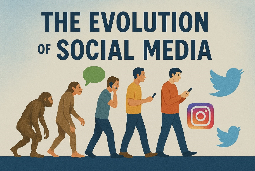
- April 26, 2025
The Evolution of Social Media
From text-based forums in the early internet days to the visually-driven platforms we use today, social media has come a long way. It has changed the way we connect, communicate, and consume information—shaping everything from friendships to global movements. But how did we get here? Let’s take a look at how social media has evolved over the years and what it might look like in the future. 1. The Early Days: Messaging and Forums (Pre-2000s)Before social media as we know it existed, people connected online through basic tools like:Bulletin Board Systems (BBS)Internet Relay Chat (IRC)AOL Instant Messenger (AIM)Early forums and message boardsThese platforms allowed people to share ideas and connect over common interests, but there were no profiles, timelines, or likes—just text-based interactions. 2. The Rise of Social Networks (2000–2010)The early 2000s saw the rise of the first true social networks—websites where users could create profiles, share updates, and interact with others.Friendster (2002) – One of the first platforms to popularize the concept of online “friends.”MySpace (2003) – Gave users the freedom to customize their profiles, post music, and create personal blogs.Facebook (2004) – Originally for college students, Facebook revolutionized how people connected, and eventually opened up to everyone.During this period, social media became more personal and began to reflect real-life relationships, schools, and communities. 3. The Age of Sharing: Multimedia Takes Over (2010–2015)This era marked a shift from text to photos, videos, and short updates. Social media became less about who you knew and more about what you shared.Twitter (2006) brought microblogging to the mainstream.Instagram (2010) focused on photo sharing, filters, and visual storytelling.Snapchat (2011) introduced disappearing messages and the idea of "in-the-moment" content.YouTube (launched in 2005, but exploded in popularity in this era) became the go-to for video content creators.These platforms changed how people expressed themselves, made content creation easier, and turned regular users into influencers. 4. The Era of Influence and Monetization (2015–2020)As platforms grew, so did the opportunity to turn followers into careers. Social media influencers, brand sponsorships, and content monetization became the norm.TikTok (launched globally in 2018) exploded in popularity with short-form, music-driven video content.Instagram Stories and Reels added more ways to share bite-sized content.Algorithms began shaping what people saw—based on engagement, interests, and advertising goals.Social media became a full-blown industry, shaping trends in fashion, music, politics, and more. 5. Current Trends: Authenticity, Community, and AI (2020–Present)Today’s users crave connection, authenticity, and niche communities. Newer platforms and updates reflect these values:BeReal encourages spontaneous, unfiltered sharing.Discord offers community-driven spaces for everything from gaming to studying.AI-generated content and virtual influencers are becoming more common.Privacy and mental health are now central concerns, as people look for healthier ways to use social media.Social platforms are also experimenting with mixed reality, creator tools, and subscription models—showing how flexible and fast-changing this space continues to be. 6. The Future of Social MediaLooking ahead, social media will likely become more immersive and interactive:Augmented and Virtual Reality (AR/VR) will play a bigger role (think: virtual hangouts, AR filters).AI-powered personalization will make feeds even more tailored.Decentralized platforms might grow in popularity as people seek more control over their data.Focus on mental wellness will continue to shape how apps are designed and used. Final ThoughtsSocial media has evolved from simple messages and profile pages to complex networks of communication, commerce, and culture. It’s changed how we socialize, learn, work, and advocate for change. And it’s not done evolving.Whether you're a casual user, content creator, or digital native, staying informed about these shifts helps you use social media in smarter, more meaningful ways.From AIM to AI—social media continues to shape the world, one post at a time.


